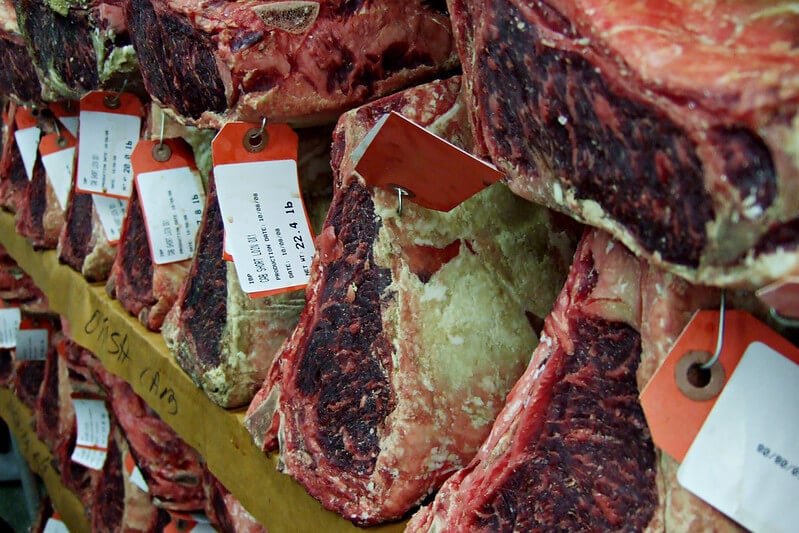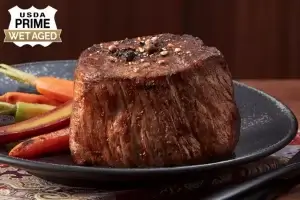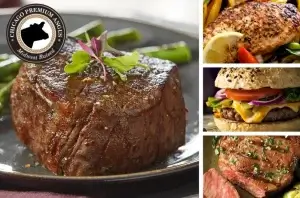
Photo by Filipe Fortes licensed under CC BY-SA 2.0
Prime. Choice. Select. USDA approved. Gourmet. Supercalifragilisticexpialidocious…. Okay, so maybe we made that last one up, but each of the other words and phrases are used on a regular basis by butchers and purveyors of beef, whether online or in your local market, to describe their various available selections and cuts. We’ve gone into detail regarding some of these mysterious terms, but there’s one we’ve yet to delve into. That would be dry-aged steak or beef.
While at Steak University we tend to consider this more of a preparation than a type, there’s no denying that dry-aged is a label that’s here to stay in the premium meat market, and rightly so. We may be biased, but it’s our opinion that there’s few things that can top a fine meal of dry-aged, premium, USDA prime beef. Now that we’ve piqued your culinary interest sit back, we’ve got all the what’s, why’s, how’s and even a couple of scientific facts, behind the gourmet delicacy that is dry-aged steak.
Table of Contents
What is Dry Aged Steak – The Science Behind the Hype
Before we get into the fine details of cooking dry aged steak at home, first a few definitions. Dry-aging a steak involves storing meat, uncovered, in a chilled environment for an extended period of time. While this seems awfully simplistic, there’s a number of highly complicated process that take place in the meat as a result of this treatment.
To start, by allowing the steak to sit uncovered and dry, the liquids within the meat begin to evaporate, condensing both the remaining moisture and the corresponding flavor. But wait, you might be saying. Doesn’t the tenderness of a steak depend on the moisture content and therefore, shouldn’t a dry-aged steak be tougher? While the logic seems sound at first glance, dry-aging meat causes a variety of other enzymatic and bacterial processes within the meat, breaking down proteins and naturally tenderizing the steak. What we’re left with is a cut of steak that, as a result of the dry-aging process, is more flavorful and tender at the same time.
How to Dry Age Steak at Home
Now that we’ve hyped this most excellent method for preparing steak, we need to get down to the nitty gritty of just how to dry age steak. Large specialty butchers, high end steakhouses and gourmet dry aged steak online retailers typically have dedicated dry-aging rooms that control factors such as temperature, humidity and air circulation.
These extreme, dedicated set-ups will be impractical for most home chefs looking to impress at their next meat-centric dinner party. The good news is that, while handy, high tech equipment isn’t required and you can dry age meat in your own home refrigerator or spare mini-fridge with a little bit of prep work.
You’ll need to start with a larger, multi-steak cut of meat, preferably with a large amount of fat coating still remaining. You need the size and fat to protect the meat and leave you some substance to work with when you trim off the desiccated or wasted portions of your dry-aged meat when it’s done prepping.
Simply place your roast or similar hunk of beef in a refrigerator, uncovered for a minimum of 7 days and up to two weeks. Remove meat from refrigerator when ready to eat, trim off the inedible hardened parts (this is where a fat cap comes in to save the day and the underlying meat) and cook via your favorite method. Some folks recommend wrapping your dry-aged beef loosely in cheese cloth and others create complicated air circulation methods via small fans placed in the fridge. While we wouldn’t discourage good old fashioned experimentation, the truth is you simply don’t need to complicate things to get the benefits of dry aged steak at home.
Dry-Aged Tips
- The ideal temperature for dry aging beef is between 34-38° F
- Using a vacuum sealed bag will protect beef against contamination from other foods
- Airflow is an important to ensure beef will dry-age properly
- For optimal taste dry-age beef for 28-40 days
Other Dry Aged Steak Options
At this point you might be saying that dry aging a steak at home may be all well and good, but it still sounds like a bit too much work for my tastes. In that case, you’re in luck. At Chicago Steak Company we dry age our premium USDA Prime steaks in a special dry aging room, trimming and then individually wrapping steaks after they’ve been aged to tasty, flavorful perfection. Our steaks are then shipped direct to your door, precisely aged and ready to eat. Whether you purchase your dry aged steak online or do it yourself at home, you can’t go wrong with giving your high quality, premium meat a chance to mature and age prior to delving in.



